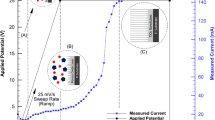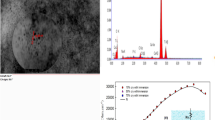Abstract
Hydroxyapatite (HA) depositions on metallic biomedical implants have been widely applied to generate bioactive surfaces in simulated biological environments. Meanwhile, highly ordered TiO2 nanotubes obtained via anodization have attracted increasing interest for biomedical applications. However, the capability to grow HA coating on TiO2 nanotubes at room temperature remains problematic. In this study, we applied a dipping treatment for biomimetic formation of an adhesive HA coating on titanium dioxide nanotubes. The coatings formed using this procedure did not require high-temperature annealing or high supersaturation of the simulated biological condition. The as-formed TiO2 nanotubes on titanium were treated using several dip-and-dry steps, through which the TiO2 nanotubes were filled and covered with calcium phosphate nucleation sites. The specimens readily grew HA once immersed in the original simulated biological fluid (SBF) after little more than 12 hours. The carbonated HA coating was formed with 10-μm thickness after 4 days of immersion, while only a few calcium phosphate particles were observed on annealing TiO2 nanotubes immersed in the same solution for the same duration. Tensile testing showed that the bonding strength between HA coating and substrate was 27.2 ± 1.6 MPa. This treatment dramatically improved efficiency for promoting HA formation on anodic TiO2 nanotubes at room temperature.












Similar content being viewed by others
Notes
JEOL is a trademark of Japan Electron Optics Ltd., Tokyo.
References
N. Sykaras, A.M. Iacopino, V.A. Marker, R.G. Triplett, and R.D. Woody: J. Oral. Max. Impl., 2000, vol. 11, pp. 675–90.
A.C. Fraker: Corrosion and Degradation of Implant Materials, 2nd Int. Symp., A.C. Fraker and C.D. Griffin, eds., ASTM, Philadelphia, PA, 1985, pp. 384–90.
S. Tamilselvi, V. Raman, and N. Rajendran: Electrochim. Acta, 2006, vol. 52, pp. 839–46.
W. Österle, D. Klaffke, M. Griepentrog, U. Gross, I. Kranz, and C. Knabe: Wear, 2008, vol. 264, pp. 505–17.
M. Textor, C. Sittig, V. Frauchiger, S. Tosatti, and D. Brunette: in Titanium in Medicine: Materials Science, Surface Science, Engineering, Biological Responses and Medical Applications, D. Brunette, D. Tengvall, M. Textor, and P. Thomsen, eds., Springer-Verlag, Berlin, 2001, pp. 171–244.
Y. Han, S.-H. Hong, and K. Xu: Surf. Coat. Technol., 2003, vol. 168, pp. 249–58.
R. Wang and K. Duan: J. Mater. Chem., 2006, vol. 16, pp. 2309–24.
X. Liu, P.K. Chu, and C. Ding: Mater. Sci. Eng. R, 2004, vol. 47, pp. 49–124.
Y. Yang, J.L. Ong, and J. Tian: Biomaterials, 2003, vol. 24, pp. 619–27.
X. Zhao, X. Liu, and C. Ding: J. Biomed. Mater. Res., 2005, vol. 75A, pp. 888–94.
D.K. Pattanayak, T. Kawai, T. Matsushita, H. Takadama, T. Nakamura, and T. Kokubo: J. Mater. Sci. Mater. Med., 2009, vol. 20, pp. 2401–11.
H.-M. Kim, F. Miyaji, T. Kokubo, and T. Nakamura: J. Biomed. Mater. Res., 1996, vol. 32, pp. 409–17.
A. Rakngarm, Y. Miyashita, and Y. Mutoh: J. Mater. Sci. Mater. Med., 2008, vol. 19, 1953–61.
B. Yang, M. Uchida, H.-M. Kim, X. Zhang, and T. Kokubo: Biomaterials, 2004, vol. 25, pp. 1003–10.
A. Arvidsson, V. Franke-Stenport, M. Andersson, P. Kjellin, Y.-T. Sul, and A. Wennerberg: J. Mater. Sci. Mater. Med., 2007, vol. 18, pp. 1945–54.
Q. Tang, R. Brooks, N. Rushton, and S. Best: J. Mater. Sci. Mater. Med., DOI:10.1007/s10856-009-3841-y.
M.A. Lopez-Heredia, P. Weiss, and P. Layrolle: J. Mater. Sci. Mater. Med., 2007, vol. 18, pp. 381–90.
P. Habibovic, F. Barrère, C.A. Van Blitterswijk, K. De Groot, and P. Layrolle: J. Am. Ceram. Soc., 2002, vol. 85, pp. 517–22.
K. De Groot, R. Geesink, C.P. Klein, and P. Serekian: J. Biomed. Mater. Res., 1987, vol. 21, pp. 1375–81.
Y.C. Tsui, C. Doyle, and T.W. Clyne: Biomaterials, 1998, vol. 19, pp. 2015–29.
Y.C. Tsui, C. Doyle, and T.W. Clyne: Biomaterials, 1998, vol. 19, pp. 2031–43.
K.A. Gross and C.C. Berndt: J. Biomed. Mater. Res., 1998, vol. 39, pp. 580–87.
Y.C. Yang and E. Chang: Biomaterials, 2001, vol. 22, pp. 1827–36.
A. Tonino, C. Oosterbos, A. Rahmy, M. Therin, and C. Doyle: J. Bone Jt. Surg. Am., 2001, vol. 83, pp. 817–25.
S. Ono, A. Kiyotake, and H. Asoh: ECS Trans., 2008, vol. 11, pp. 1–8.
H. Tsuchiya, J.M. Macak, L. Müller, J. Kunze, F. Müller, P. Greil, S. Virtanen, and P. Schmuki: J. Biomed. Mater. Res., 2006, vol. 77A, pp. 534–41.
S. Bauer, S. Kleber, and P. Schmuki: Electrochem. Commun., 2006, vol. 8, pp. 1321–24.
A. Ghicov, H. Tsuchiya, J.M. Macak and P. Schmuki: Electrochem. Commun., 2005, vol. 7, pp. 505–08.
J. Tao, J. Zhao, C. Tang, Y. Kang, and Y. Li: New J. Chem., 2008, vol. 32, pp. 2164–68.
J. Kunze, L. Müller, J.M. Macak, P. Greil, P. Schmuki, and F.A. Müller: Electrochim. Acta, 2008, vol. 53, pp. 6995–7003.
J. Park, S. Bauer, K.A. Schlegel, F.W. Neukam, K. Von Der Mark, and P. Schmuki: Small, 2009, vol. 5, pp. 666–71.
K. Das, A. Bandyopadhyay, and S. Bose: J. Am. Ceram. Soc., 2008, vol. 91, pp. 2808–14.
J. Park, S. Bauer, K. Von Der Mark, and P. Schmuki: Nano Lett., 2007, vol. 7, pp. 1686–91.
X. Xiao, T. Tian, R. Liu, and H. She: Mater. Chem. Phys., 2007, vol. 106, pp. 27–32.
B. Feng, X. Chu, J. Chen, J. Wang, X. Lu, and J. Weng: J. Porous Mater., DOI:10.1007/s10934-009-9307-2.
H.B. Wen, Q. Liu, J.R. De Wijn, K. De Groot, and F.Z. Cui: J. Mater. Sci. Mater. Med., 1998, vol. 9, pp. 121–28.
T. Kokubo and H. Takadama: Biomaterials, 2006, vol. 27, pp. 2907–15.
H.-M. Kim, F. Miyaji, T. Kokubo, and T. Nakamura: J. Biomed. Mater. Res. Appl. Biomater., 1997, vol. 38, pp. 121–27.
M. Uchida, H.-M. Kim, T. Kokubo, S. Fujibayashi, and T. Nakamura: J. Biomed. Mater. Res., 2003, vol. 64A, pp. 164–70.
D.K. Pattanayak, T. Kawai, T. Matsushita, H. Takadama, T. Nakamura, and T. Kokubo: J. Mater. Sci. Mater. Med., 2009, vol. 20, pp. 2401–11.
R. Horváthová, L. Müller, A. Helebrant, P. Greil, and F.A. Müller: Mater. Sci. Eng. C, 2008, vol. 28, pp. 1414–19.
C. Rey, C. Combes, C. Drouet, H. Sfihi, and A. Barroug: Mater. Sci. Eng. C, 2007, vol. 27, pp. 198–205.
“Implants for surgery-hydroxyapatite-part 2: Coating of hydroxyapatite,” ISO 13779-2 2008, second edition.
A. Kodama, S. Bauer, A. Komatsu, H. Asoh, S. Ono, and P. Schmuki: Acta Biomater., 2009, vol. 5, pp. 2322–30.
E. Landi, G. Celotti, G.. Loggroscino, and A.J. Tampieri: J. Euro. Ceram. Soc., 2003, vol. 23, pp. 2931–37.
I.R. Gibson and W. Bonfield: J. Biomed. Mater. Res., 2002, vol. 59, pp. 697–708.
S.M. Barinov, J.V. Rau, S. Nunziante Cesaro, J. Ďurišin, I.V. Fadeeva, D. Ferro, L. Medvecky, and G. Trionfetti: J. Mater. Sci. Mater. Med., 2006, vol. 17, pp. 597–604.
T. Nakamura, T. Yamamuro, S. Higashi, T. Kokubo, and S. Itoo: J. Biomed. Mater. Res., 1985, vol. 19, pp. 685–98.
K. Duan, A. Tang, and R. Wang: Mater. Sci. Eng. C, 2009, vol. 29, pp. 1334–37.
Acknowledgments
This work was supported by the Natural Sciences and Engineering Research Council of Canada. One of the authors (LW) thanks Dr. Xinhu Tang for the valuable discussion of the nanotube growth.
Author information
Authors and Affiliations
Corresponding author
Additional information
Manuscript submitted March 15, 2010.
Rights and permissions
About this article
Cite this article
Wang, Ln., Luo, Jl. Formation of Hydroxyapatite Coating on Anodic Titanium Dioxide Nanotubes via an Efficient Dipping Treatment. Metall Mater Trans A 42, 3255–3264 (2011). https://doi.org/10.1007/s11661-010-0484-z
Published:
Issue Date:
DOI: https://doi.org/10.1007/s11661-010-0484-z




